#von amman
Photo
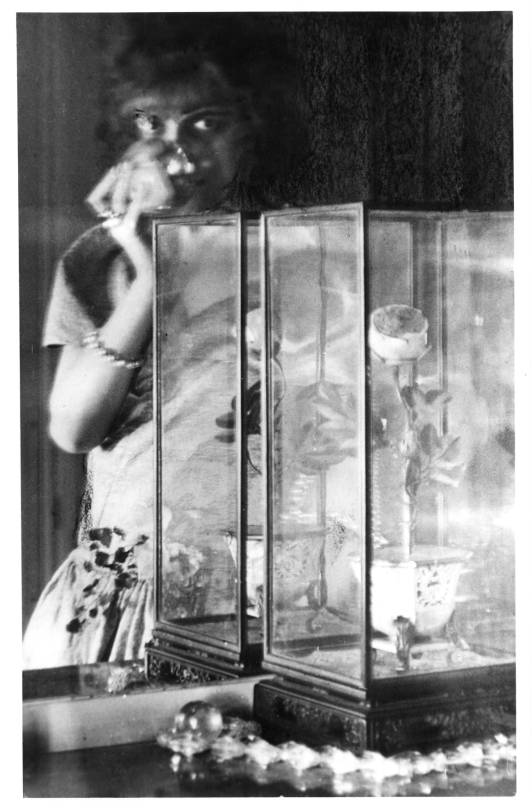
1922 Man Ray, Marchesa Luisa Casati.
"In 1922, Luisa visited a young and still unknown photographer named Man Ray. In his autobiography, the American tells the story of the photo that became the most famous of all the representations of the Marchioness Casati (...) "I drew a few where one could distinguish a semblance of face; On one of the negatives, we saw three pairs of eyes. It could have been mistaken for a surreal version of the Medusa. It was precisely this photo that delighted her: I had made a portrait of her soul, she said, and she ordered dozens of copies from me. I wish my other clients had been so easy to please. The photo of the marquise went around Paris. Figures from the most closed circles began to come, all expecting miracles. I had to leave my hotel room and find a real studio. » (x)
#1922#portrait#man ray#marchesa luisa casati#luisa casati#marchesa casati#marquise casati#Marquise luisa casati#la Marquise#luisa amman casati#Luisa Adele Rosa Maria von Amman#Luisa Adele Rosa Maria Amman#Luisa Amman#Marquise Casati Stampa di Soncino#Marchesa Casati Stampa di Soncino#Luisa Marchesa Casati Stampa Di Soncino#Luisa Casati Stampa di Soncino#Marchesa Casati Stampa
155 notes
·
View notes
Text
16th c. Costume Books, a Problematic Source for Dress History

But did they really dress like this?
Costume books and costume albums are a popular source for dress historians, historical costumers, and reenactors researching 16th and early 17th c. Europe. There are good reasons for this. They are primary source documents (at least sometimes), and they show the clothing of cultures and social groups that are difficult-to-impossible to find in other types of period art, like the Irish and rural peasants. Examples of these books include Trachtenbuch des Christoph Weiditz, Habiti antichi et moderni di tutto il Mondo di Cesare Vecellio, and Théâtre de tous les peuples et nations de la terre avec leurs habits et ornemens divers. These books are, however, deeply problematic as a dress history source for several reasons. In this post, I will discuss the ways they are problematic and how those of us researching historical dress can gain a better understanding of what the people shown in these books were actually wearing. I have broken down the problems with using these images into 4 areas.
Embodied biases:
The creators of these books were, at least sometimes, prejudiced against the cultures they were portraying, and these biases may have affected how they characterized these cultures. Hans Weigel, author of Habitus praecipuorum populorum, characterized his native German fashion as modest and virtuous and characterized elaborate Italian fashions as decadent and corrupt. Weigel considered these 'strange' foreign fashions a threat to the 'civilized' German fashion he favored (Bond 2018). This bias might have motivated Weigel to idealize his portrayal of German fashion or to exaggerate the strangeness of Italian fashion in order to scare his readers away from trying it.
Weigel's dislike of flashy foreign fashions seems mild in comparison to the bigotry of some of his peers. Flemish artist Lucas de Heere and French artist François Desprez both labeled the Scottish 'savages' in their books. Jost Amman's description of a purported Turkish sex worker in the German edition of Gynaeceum, sive Theatrum mulierum, is appallingly bigoted:
"A Turkish Wh*re: This is a prostitute, who sells her impure body for dirty money to a lover that pleases her. With the earnings of this sin she dresses herself prettily and beautifully, in order to attract the Turks even more easily with her false ornaments." (translation from Ilg 2004)
Considering the blatant bigotry he shows here, I wouldn't anything about trust Amman's depictions of sex workers, Turks, or any other non-Western Europeans. Or any other women, really.
Sights unseen:
Even when costume book creators weren't actively trying to perpetuate their biases through their work, their ignorance could still cause problems. These artists did not always visit the countries whose costumes they painted. They relied on other artists' work or even just verbal descriptions to fill in the gaps in their knowledge. The resulting images can distort the cut, construction, and material of the clothing.
For example, the Turkish women in this original woodcut by Pieter Coecke van Aelst are wearing shawls or scarves with long fringe wrapped around their heads and shoulders. In the Christoph von Sternsee costume album's illustration based off Coecke van Aelst's print, the fringed shawl has become a strange, tailored hood with a panel of pleated cloth attached to either it or the gown below.
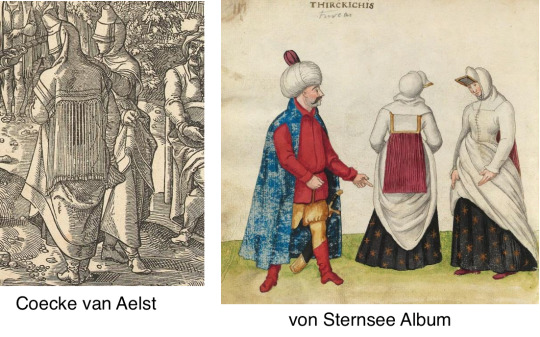
(Coecke van Aelst's woodcuts were identified as the source for the von Sternsee album's illustration in Katherine Bond's 2018 dissertation.)
Copy of a copy of what?
In spite of the problems it causes, copying from other artists' work was common in costume albums (Bond 2018). Considering that the artists did not visit all the cultures they illustrated, this is unsurprising. Some images were copied repeatedly, and the artist misunderstanding the source material wasn't the only source of distortion. Artists also made up details to compensate for bare-bones source material.
This simple line black-and-white print of an Irish woman wearing a léine (linen tunic), brat (Irish mantle), and headwear was used by several artists, all of whom made changes and additions. The first copy in this post is the most faithful to the original, but it still adds long sleeves and eyelet holes on the neckline to the léine. The coloring of the headwear suggests a wool hat crested with a tuft of horsehair and having a linen roll at the bottom. The coloring also gives the brat a contrasting lining.
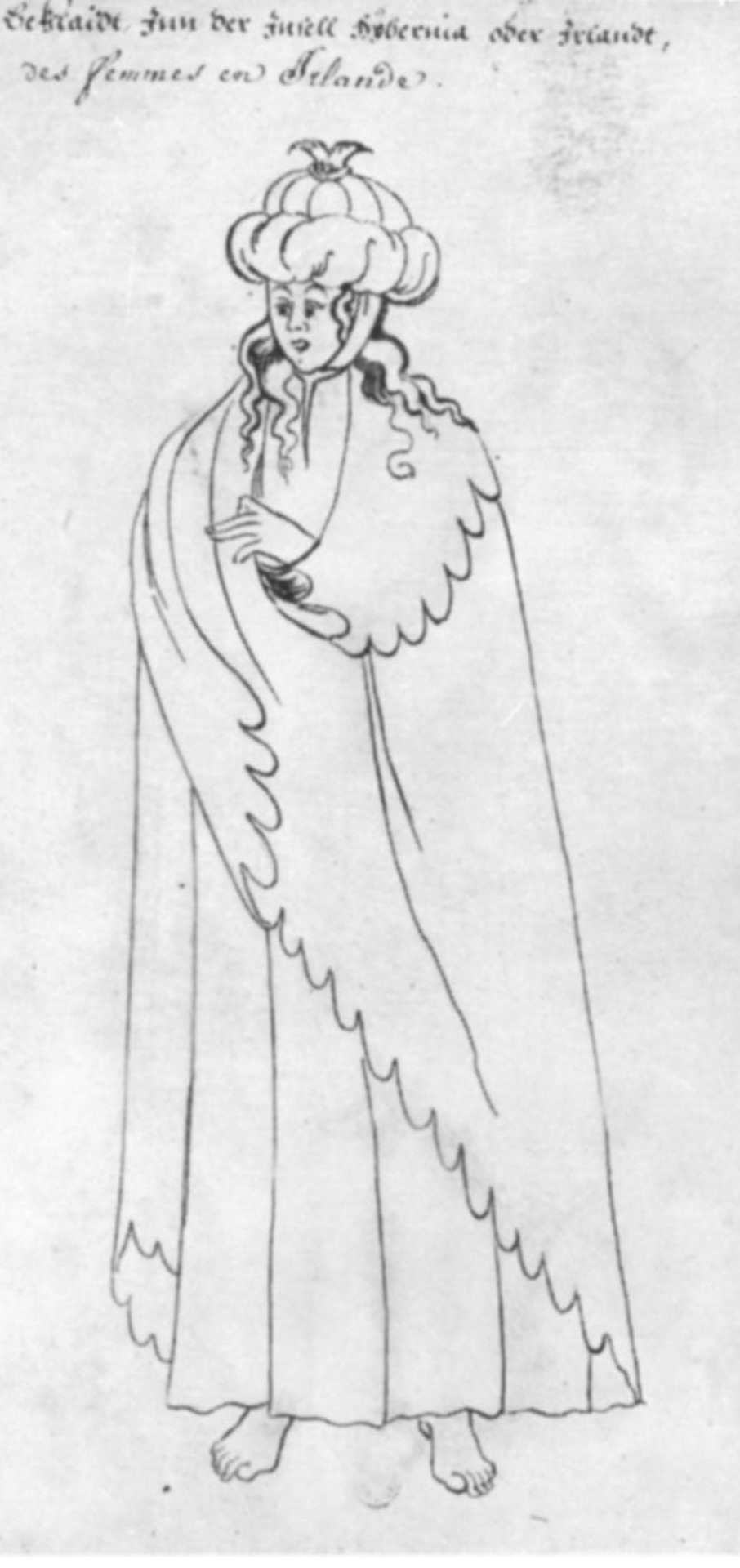

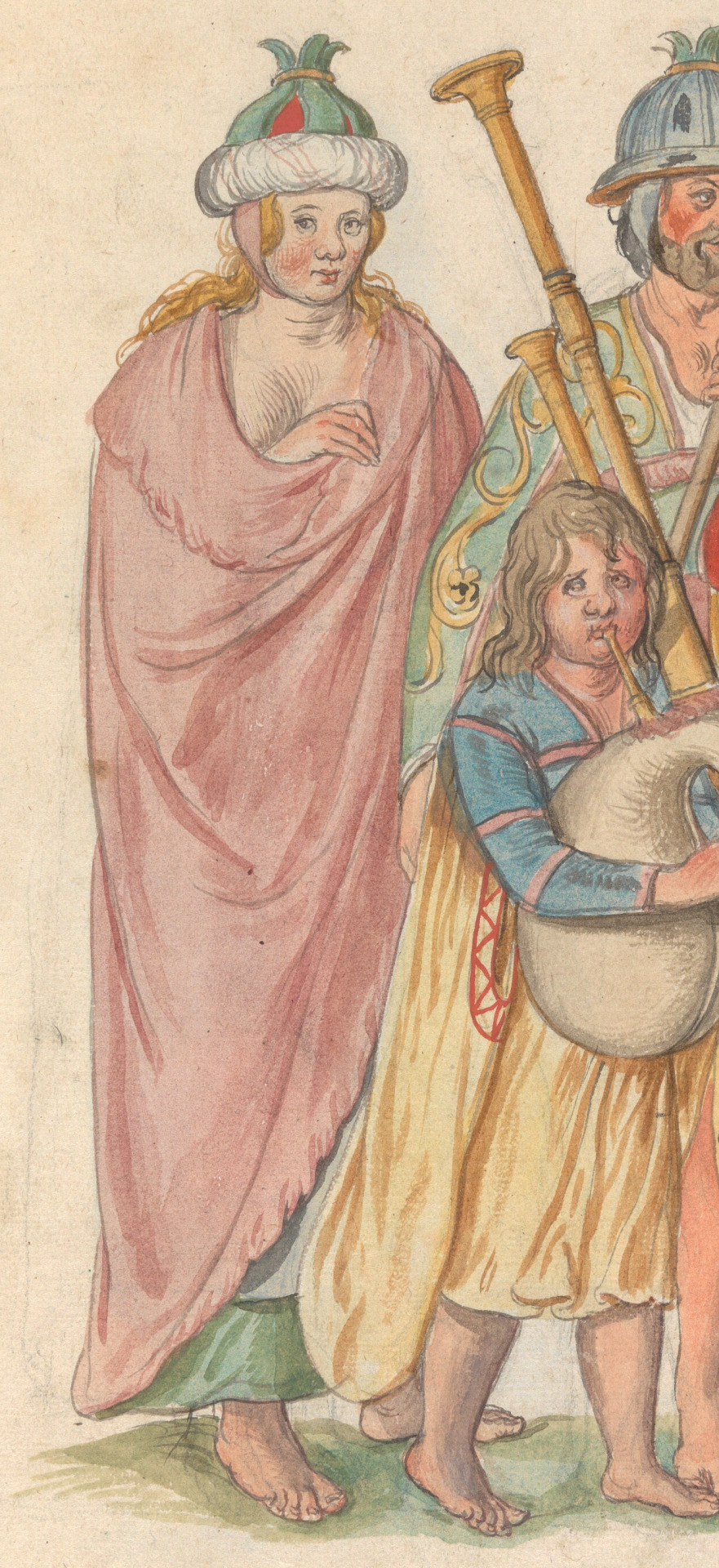

The second knockoff is the most famous. It comes from Lucas De Heere's illustration which purportedly shows Irish people in service to King Henry VIII. This is some thing De Heere couldn't have actually seen, as he moved to England 20 years after Henry VIII died and never went to Ireland at all. De Heere took the most liberties with his version. His Irish woman appears to be topless under her brat. The bottom of her léine has much less volume than the original, and De Heere has added an apron. For the hat, De Heere has replaced the crest with triangles of green wool.
Unlike De Heere's version, the final version is mostly loyal to the cut shown in the original, but it makes some unlikely suggestions for the materials. The léine appears to be green silk brocade. The brat also appears to be silk. Accounts from people who actually went to Ireland in the 16th and early 17th centuries state that these garments were made of linen and wool, respectively. Both the hat and its crest are now completely made of linen.
Chronological distortion:
The heavy use of copying in costume books also has the potential to mislead us in terms of when these fashions were worn, because the original images may be significantly older than publication year of the books that copy them. For example, the dress of Livonian women shown in Hans Weigel's 1577 book was almost certainly copied from Albrecht Dürer's 1521 watercolors. Weigel used references that were more than half a century old, but described them as if they were contemporary fashion in 1577.
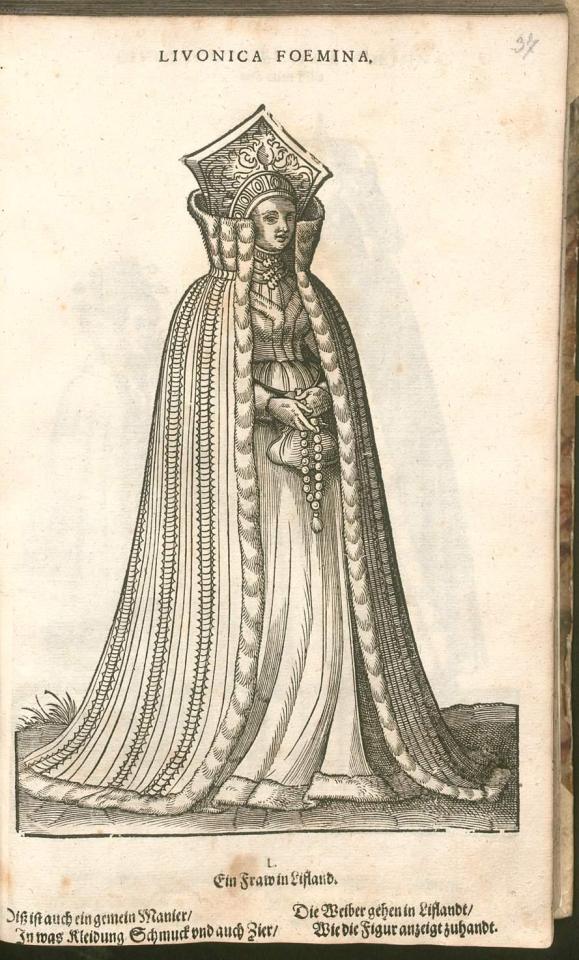
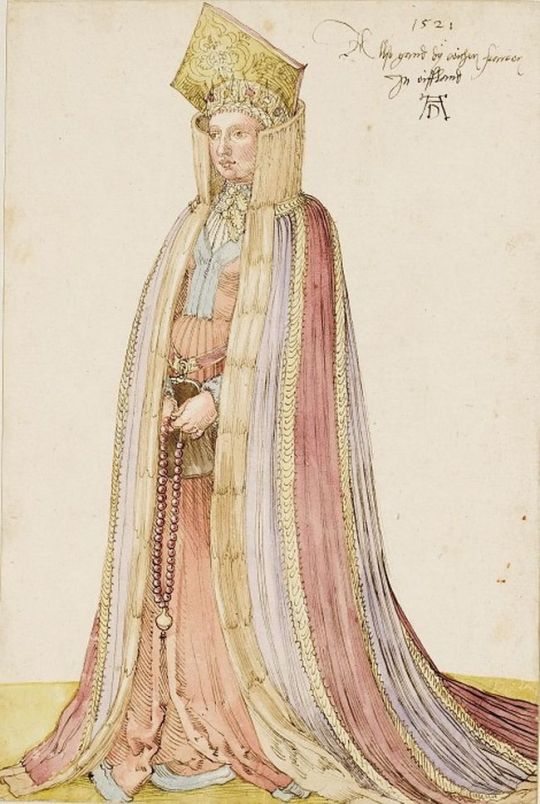
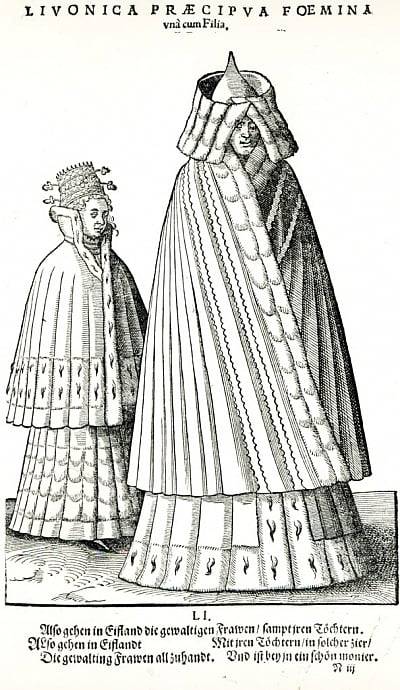
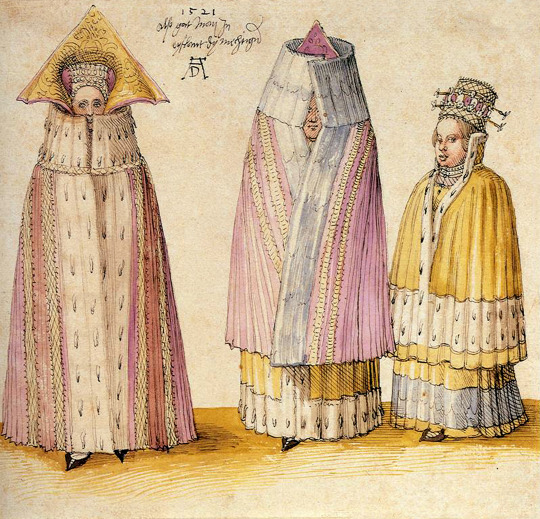
Even when costume book images are accurate portrayals of their source material, many of them lack the detail needed to identify seams, fabric types, or garment understructures. How do we deal with these problems when attempting to reconstruct what the people shown in these books actually wore?
What do we do about it?
I am not saying that we should discard these things completely as sources. Dress historians as respected as Patterns of Fashion author Janet Arnold and The Tudor Tailor authors Jane Malcolm and Ninya Mikhaila have used costume book illustrations. I definitely know less about 16th c. dress history than Jane and Ninya. I am just saying we shouldn't use them uncritically.
First, do some research on the costume book you're looking at. When was it created? Do the illustrations look suspiciously similar to those in other books? (Google image search and pinterest can be helpful for identifying this.) Did the creator, like Hans Weigel, have a particular bias they were advancing? Did they actually visit the cultures they portrayed? Christoph Weiditz actually traveled quite a bit, but he did not visit the British Isles, so his Irish and English women are probably based on someone else's art (Bond 2018). A lot of the scholarly publications about costume books are frustratingly paywalled, but some of them can be accessed for free via researchgate or academia.edu.
Avoid using copies when possible, even if the copies are more realistic-looking or more detailed art. As I discussed in the examples above, artists change things when they copy. Publication dates of copies can also be misleading in terms of dating clothing styles.
Find other sources such as: written descriptions from the time period, extant historical garments, more detailed art depicting similar fashions in related cultures, and art made by people from the culture you are studying. Period written descriptions can yield information about materials used, colors, and other details. Extant garments are your best source for information on cut and construction (unless you are lucky enough to have an extant tailor's manual from your period and culture). Detailed art depicting similar fashions can offer suggestions to fill in for missing information on construction, materials, and embellishments. Art created by the culture is valuable for identifying inaccuracies created by bigoted or ignorant artists.
Finally, remember that it's okay to not know everything. There are gaps in our knowledge about what people wore 500 years ago that will probably never be filled without a time machine. Sometimes you just have to make a plausible guess and move on. Don't let yourself get so paralyzed by doing research that you never complete the garment reconstruction/art/tumblr post you were doing the research for.
Bibliography:
Bond, K. L. (2018). Costume Albums in Charles V’s Habsburg Empire (1528-1549). https://doi.org/10.17863/CAM.25054
Dunlevy, Mairead (1989). Dress in Ireland. B. T. Batsford LTD, London.
Ilg, Ulrike. (2004). The Cultural Significance of Costume Books Sixteenth-Century Europe. In Catherine Richardson (ed.), Clothing Culture, 1350-1650 (p. 29-47). Ashgate.
McClintock, H. F. (1943). Old Irish and Highland Dress. Dundalgan Press, Dundalk.
McClintock, H. F. (1953). Some Hitherto Unpublished Pictures of Sixteenth Century Irish People, and the Costumes Appearing in Them. The Journal of the Royal Society of Antiquaries of Ireland, 83(2), 150-155. https://www.jstor.org/stable/25510871
Costume Books mentioned:
Amman, Jost. Gynaeceum, sive Theatrum mulierum.
The Costume Album of Christoph von Sternsee. not available on-line. Katherine Bond's research is your best source for this one.
Desprez, François. Recueil de la diversité des habits.
De Heere, Lucas. Corte Beschryvinghe van Engheland, Schotland, ende Irland.
Théâtre de tous les peuples et nations de la terre avec leurs habits et ornemens divers, tant anciens que modernes, diligemment depeints au naturel par Luc Dheere peintre et sculpteur Gantois.
Vecellio, Cesare, and Gratilianus, Sulstatius. Habiti antichi et moderni di tutto il Mondo di Cesare Vecellio.
Trachtenbuch des Christoph Weiditz
Weigel, Hans, and Amman, Jost. Habitus praecipuorum populorum, tam virorum quam foeminarum singulari arte depicti.
Kostüme der Männer und Frauen in Augsburg und Nürnberg, Deutschland, Europa, Orient und Afrika
Kostüme und Sittenbilder des 16. Jahrhunderts aus West- und Osteuropa, Orient, der Neuen Welt und Afrika
costume prints by an unknown artist, in the Bibliothèque nationale de France, Cabinet des Estampes. I cannot find this one online. image taken from McClintock 1953.
#dress history#historical fashion#art#16th century#17th century#historical costuming#historical dress#cw whorephobia#cw racism#irish dress#leine#irish mantle#reenactment#costume album
196 notes
·
View notes
Text
While I was cleaning today, I ended up listening to the 2006 Rebecca cast album for the very first time (I'd only listened to some of the songs previously). Here are some random thoughts and reactions that came up, because why not. This will probably be a long post so buckle up:
the characters feel very vivid and I love that a lot.
it's interesting to hear some of the lines they changed for the Monte Carlo scenes.
I actually love the second verse of "Zeit in einer Flasche". I wish they'd kept it. It's very sweet and creates a more satisfying lead-up to the conclusion of the song imo.
this recording is proof that "Zauberhaft natürlich" doesn't add anything to the show. Uwe Kröger already makes Maxim seem quite human in only a few minutes. Plus, I always feel like the Monte scenes could be shorter overall (Yes I know what I just said about "Zeit in einer Flasche".)
If I hadn't already been completely won over by Susan!Danny I would be now. She's so poised and brings so much nuance to the character in "Die Neue Mrs de Winter" alone. Her first "Madam" sounds so threatening, I love it.
Also... 2005 Elisabeth Franz Joseph as Frank startled me a little.
Absolutely adore Susan's "Sie ergibt sich nicht"
Kerstin Ibald as Beatrice is a delight in every single way. Also interesting to see the different choices she made between Vienna and Stuttgart.
Speaking of Beatrice... "Die Stärke einer Frau" is... so long. I listened to it on the way home from running an errand and I ended up laughing to myself in the middle of the street because it is kind of a ridiculous song. Imo the only reason not to cut it is because we love Beatrice.
Here's something I found really interesting: Favell and Danny actually have a dynamic in this recording. I fully believe that they've known each other for decades. They might not particularly like each other, but they're definitely familiar with each other. I can imagine them as a comedic duo honestly. This Favell in general is very vivid, very emotional. I like that. I feel like he has more nuance than the later depictions. Also... "Ich liebte sie genau wie du". Excuse me??? I love that line!
I'm so glad they ended up replacing "Wir sind Britisch" with "Merkwürdig". "Wir sind Britisch" did not work for me as a song and felt out of character for the show in general. It was like they were trying to be My Fair Lady for a hot second.
I didn't think I would like Uwe!Maxim that much, but actually! I might like him the best out of the three cast recordings. Jan Amman is my fave vocally, but I love how Uwe portrays Maxim as a character. Again, there's nuance here. I also love the way he says "Oh, das ist Frank Crawley der Verwalter von Manderley..."
There's a really interesting line in "Die Neue Mrs de Winter (Reprise)" where the ensemble says something about Ich being "Fast wie unsere alte Mrs de Winter". That's a really interesting callback to the book and the way the book's narration begins to draw parallels between Ich and Rebecca, in whichever way you want to interpret that.
Okay, everyone who's been telling me about how excellent Susan!Danny is was completely correct and justified. Her Mrs Danvers comes across as very controlled, but her feelings really come through as well. Her "ich Hör Dich Singen" is beautiful. I would give a lot to hear her sing it again with the new lyrics. I know I keep saying this but NUANCE. So much nuance in this character!
On a similar note, it's so refreshing to hear a Maxim played by a very passionate actor (not to say that Mark or Jan weren't passionate, just that I really enjoyed Uwe's portrayal).
This became long and quite incoherent, so if you've made it this far, thanks for reading! I'd love to hear your thoughts if anyone wants to ramble :)
#rebecca das musical#rebecca 2006#just rambling#i have so much admiration for Susan!Danny#holy shit she's good#it was super interesting to hear the show as it was originally written#I love what it's turned into it's just also interesting to compare#Kerstin Ibald as Beatrice has my whole heart#I love when they include the Schlussmusik and applause on cast albums#it always makes me cry
18 notes
·
View notes
Text

Römisches Theater von Amman.
2 notes
·
View notes
Text
Manchmal frage ich mich, ob nicht alles, was wir sind, auf einer Abfolge von Imitationen und Projektionen beruht.
Babylon
Niccolo Ammaniti
1 note
·
View note
Text
Unter den Mitgliedern der pro-iranischen Achse im Nahen Osten ist die Empörung über al-Arouris Ableben erwartungsgemäß groß und die üblichen Drohungen mit Vergeltungsschlägen ließen nicht lange auf sich warten. Wie der Blog Elders of Ziyon bemerkt, beschränkte sich die Verurteilung des Anschlags auf den Hamas-Führer aber auf diese überschaubare Gruppe, zu der Vertreter des iranischen Regimes, der Huthis im Jemen, schiitischer Milizen im Irak und einiger regionaler Zweigstellen der Muslimbruderschaft gehören.
Im Nahen Osten jenseits des iranischen Regimes und seiner Terror-Handlanger ist von Empörung über den Tod al-Arouris genauso wenig zu hören wie über Israels Krieg gegen die Hamas. Und das hat einen einfachen Grund: Anders als man in Europa vielfach nach wie vor glaubt, haben Länder wie Ägypten, Jordanien, Saudi-Arabien oder die Golfstaaten kein Problem mit Israel, sehr wohl aber mit dem iranischen Regime und seinen Verbündeten wie der Muslimbruderschaft.
Offiziell mag gelegentlich Missfallen über das Leid der Palästinenser im Krieg geäußert werden, inoffiziell wünscht man in Riad wie in Amman aber, dass Israel die Hamas möglichst schnell auslöscht.
Deshalb sind auch alle Versuche des iranischen Regimes und Syriens gescheitert, in der Arabischen Liga oder in der weiteren islamischen Welt harte Maßnahmen gegen den jüdischen Staat wie den Abbruch politischer Beziehungen oder eine totale wirtschaftliche Blockade zu ergreifen. Der Großteil der arabischen Welt sieht sich nicht von Israel bedroht, sondern von den Umtrieben des iranischen Regimes – und dagegen erweist sich Israel ein ums andere Mal als verlässlicherer Verbündeter als die USA unter den zumindest letzten drei Präsidenten.
Gestatten Sie mir, zum Schluss den Verblichenen zu Wort kommen zu lassen. In einem Interview im August letzten Jahres erklärte al-Arouri: »Ich warte auf das Martyrium (den Tod) und ich glaube, ich habe zu lange gelebt.« Zumindest diese Sichtweise wurde offenbar auch noch von jemandem anderen geteilt
0 notes
Text
"Der Wert der Wahrheit" von Detlev W. Crusius
Jean Delong arbeitet für die SRA in Amman. Sein Job – er beschafft Informationen aus dem Hexenkessel Nahost. Das Geschäftsmodell der SRA – Special Risk Analysis – ist simpel: Bei der aktuellen Inflationsrate ist Erpressung die einzige wertbeständige Valuta. Der Treibstoff des Geschäfts ist Korruption bis in höchste Regierungskreise. Ihre wichtigste Quelle ist Sheikh Turki in Dschidda. Jean Delong…

View On WordPress
0 notes
Text
Baerbock sagt 50 Millionen Euro Soforthilfe für Palästinenser zu
Tichy:»Die Millionen sollen ins Palästinenserhilfswerk UNRWA fließen, wie Baerbock bei einem Besuch in Amman zusicherte. Allerdings ist die UN-Partnerorganisation seit Jahren im Visier von Kritikern, weil mit den Geldern auch umstrittene Projekte unterstützt würden. Mit der 1949 gegründeten Organisation gibt es für Palästina-Flüchtlinge ein eigenes Hilfsprogramm, während der UNHCR für die restliche Welt zuständig ist.
Der Beitrag Baerbock sagt 50 Millionen Euro Soforthilfe für Palästinenser zu erschien zuerst auf Tichys Einblick. http://dlvr.it/Sxj7TC «
0 notes
Text
Hamas rivela: «Preparavamo l'attacco da due anni»

Hamas rivela: «Preparavamo l'attacco da due anni».
Il premier israeliano Benyamin Netanyahu ha mostrato al mondo le foto dei bambini carbonizzati da Hamas e di altre atrocità commesse contro il suo popolo nelle scorse ore, promettendo che l'organizzazione terroristica sarà «schiacciata» come è avvenuto con l'Isis.
È il sesto giorno di guerra, con la frontiera libanese sempre in ebollizione e con un raid israeliano che ha colpito l'aeroporto di Damasco.
Intanto il segretario di Stato Usa Antony Blinken è arrivato a Tel Aviv e ha ammesso che «le immagini di bambini e neonati massacrati, soldati decapitati, ragazzi bruciati vivi, sono al di là di ogni immaginazione. Quasi incomprensibili». In precedenza era stato il ministro della Difesa Yoav Gallant a mostrare i video dell'orrore ai suoi colleghi della Nato a Bruxelles.
L'attacco che ha scatenato la guerra e la cattura di oltre 150 ostaggi israeliani, secondo quanto ha dichiarato Ali Baraka, un esponente di Hamas, era in preparazione «da almeno due anni». Ma i Paesi alleati di Hamas, ha assicurato, sono stati informati solo dopo l'inizio dell’assalto.
Domani in Israele arriveranno il ministro degli Esteri Antonio Tajani, la collega tedesca Annalena Baerbock, la presidente della Commissione Ue Ursula Von der Leyen e quella dell'europarlamento Roberta Metsola. Poi si sposteranno, come Blinken, ad Amman, per vedere Abu Mazen, capo dell'Autorità Nazionale Palestinese che, incontrando re Abdallah nella capitale giordana, ha condannato «l’uccisione o gli abusi sui civili da entrambe le parti».
Il bilancio dei morti, sia in Israele sia a Gaza, sale sempre più. Nello Stato ebraico sono più di 1.300 le vittime e 3.300 i feriti, di cui 28 in condizioni critiche. È salito a 1.537 il bilancio delle vittime negli attacchi israeliani sulla Striscia di Gaza, tra cui 500 bambini e 276 donne, secondo il Ministero della Sanità palestinese. I feriti sono 6.612.
Intanto, mentre Israele avvisa che a Gaza saranno tagliate elettricità, acqua e benzina finché gli ostaggi non saranno rilasciati, l'Iran tuona: «Se lo Stato ebraico non ferma i suoi crimini di guerra contro i civili a Gaza, ci sarà una risposta»....
#notizie #news #breakingnews #cronaca #politica #eventi #sport #moda
Read the full article
0 notes
Text
Hans Sahl - Das Exil im Exil - Luchterhand Literaturverlag. Veröffentlichungen der Deutschen Akademie für Sprache und Dichtung Darmstadt, 63. Veröffentlichung. Memoiren eines Moralisten II. Der 1. Band von Hans Sahls Erinnerungen erschien 1983 unter dem genannten Titel im Amman Verlag (Zürich) und 1985 in der Sammlung Luchterhand (Darmstadt und Neuwied). Das Buch - Das Exil im Exil erschien in 3. Auflage im Jahr 1990. ISBN: 3-630-80007-6.Aufreibend ist es und beschwerlich, sich zu verweigern dem Herkömmlichen, Entscheidungen zu durchschauen, die nur Nuancen sind derselben Ratlosigkeit, die Wahrheit zu wissen, bevor sie allgemein wird. Ertragen die lange Schweigepflicht, bis alle aussprechen, was Dir zu sagen so schwer fiel, bis die Wahrheit in aller Munde ist und dadurch schon wieder fragwürdig geworden ist und beinahe falsch.
0 notes
Text
Eine jordanische Nachrichtenwebseite entschleiert die Vernetzungen zwischen der Front Polisario und den Terrorgruppen in der Sahel-und-Sahara-Region

Amman-Die jordanische Nachrichtenwebseite (Juhayna News) analysierte in einem jüngst veröffentlichten Artikel die enge Vernetzung zwischen den Söldnern der Front Polisario und den Terrorgruppen, die in der Sahel-und-Sahara-Region operieren.
Diese Informationswebseite drängte überdies die Bedrohung in den Vordergrund, die von diesen Terrorgruppen und von dieser Vernetzung mit der Front Polisario für die Gesamtregion und für den gesamten afrikanischen Kontinent ausgeht.
Dieser Nachrichtenwebseite nach hatte die Front Polisario Bündnisse mit den in der Sahelzone operierenden Terrorgruppen abgeschlossen, dabei darauf pochend, dass der berüchtigte Terrorist und Kriminelle aus der Sahelzone, bekannt als Abu Adnan Al-Sahraoui, als einen der wichtigsten Kader der Front Polisario in den Lager Tinduf gegolten hat und gilt. Und das war auch der Fall bei seinem Stellvertreter mit dem Namen Abdel Al-Hakim Al-Sahrawi, welcher ein ehemaliger Söldner der Front Polisario gewesen war.
Die Analyse der jordanischen Webseite zeigt auf, dass mehrere Operationen zur Zerschlagung von Terrorzellen, die mit dschihadistischen Gruppen in Verbindung standen und stehen, die seit 2008 in der Sahel-und-Sahara-Region operieren, Vernetzungen zwischen der Front Polisario und dem Terrorismus in der Region aufgedeckt hätten, wobei darauf verwiesen wird, dass sich die Lager Tinduf zu einem fruchtbaren Boden für das Zustandekommen terroristischer Bewegungen in den letzten Jahren ausgewachsen haben.
Die jordanische Nachrichtenwebseite stattete Bericht ab, dass sich die Front Polisario die weitverbreitete Verfügbarkeit und den Überfluss an Waffen aus dem internationalen Handel in der Sahel-Sahara-Region zunutze machte, indem sich ihre Mitglieder den in dieser Region zahlreichen Terrorbewegungen anschlossen, zwecks dessen das zerstörerische Programm dieses imaginären Gebildes umsetzen zu dürfen.
Als Beweis nahmen die jordanischen Medien die Fülle kriegerischer Erklärungen der Vertreter der Front Polisario während ihrer angeblichen Konferenzen, wo sie zu Terroranschlägen Marokko entgegen aufriefen.
Die Nachrichtenwebseite bestätigte, dass die Lager Tinduf in erster Linie als Rekrutierungsreserve für die Dschihadisten und für die unterschiedlichen Terrororganisationen betrachtet wurden und werden, die bezogen auf die salafistische Gruppe für Predigt und Kampf, woraus später die Organisation Al-Qaida zustande kam, im Islamischen Maghreb tätig geworden sind.
Sie fuhr fort, dass sich diese Lager heute zu bekannten Hauptquartieren für die Versorgung verschiedener mit „Daesh“ vernetzten Organisationen mit Terrorkandidaten und Kanonenfutter herausgestellt haben, und dies mit dem Segen und der Mittäterschaft der Führung der Front Polisario, die dem Kommando des Militärregimes eines Landes untersteht, das weiterhin diesem sogenannten Gebilde politische, diplomatische, finanzielle und militärische Unterstützung zukommen lässt und dazu beisteuert, dass die Gewalt, das Leid und der Schmerz, die der abgesonderten Population der Lager Tinduf zugefügt wurden und werden, 50 Jahre hindurch andauern, indem ihnen die grundlegendsten Rechte auf Freizügigkeit und auf ein menschenwürdiges Leben entzogen wurden und werden.
Sie unterstrich, dass diese Absprache zwischen der Front Polisario und den Terrororganisationen vermöge der Untersuchungen der marokkanischen Anti-Terror-Dienste nachweislich ist und in der laufenden Zerschlagung der Terrorzellen widerspiegele.
Zum Schluss stellte die Nachrichtenwebseite die Verantwortung der gesamten internationalen Gemeinschaft klar heraus, ihre Anstrengungen intensivieren zu haben, um dieser neuen Brutstätte des Extremismus ein Ende bereiten zu dürfen, die die Zukunft der Gesamtregion und des gesamten afrikanischen Kontinents belastet.
Quellen:
http://www.corcas.com
http://www.sahara-online.net
http://www.sahara-culture.com
http://www.sahara-villes.com
http://www.sahara-developpement.com
http://www.sahara-social.com
0 notes
Photo

1922 Man Ray, Marchesa Luisa Casati.
"In 1922, Luisa visited a young and still unknown photographer named Man Ray. In his autobiography, the American tells the story of the photo that became the most famous of all the representations of the Marchioness Casati (...) "I drew a few where one could distinguish a semblance of face; On one of the negatives, we saw three pairs of eyes. It could have been mistaken for a surreal version of the Medusa. It was precisely this photo that delighted her: I had made a portrait of her soul, she said, and she ordered dozens of copies from me. I wish my other clients had been so easy to please. The photo of the marquise went around Paris. Figures from the most closed circles began to come, all expecting miracles. I had to leave my hotel room and find a real studio. » (x)
#1922#portrait#photography#man ray#marchesa luisa casati#luisa casati#la casati#la marquesa#marquise casati#casati#marchesa casati#Marchesa Casati Stampa#luisa amman casati#Luisa Adele Rosa Maria von Amman#Luisa Amman#Luisa Adele Rosa Maria Amman#amman#Marquise Casati Stampa di Soncino#Marchesa Casati Stampa di Soncino#Luisa Marchesa Casati Stampa Di Soncino#Luisa Casati Stampa di Soncino#la Marquise#Marquise luisa casati#marquise#medusa#soul#emmanuel radnitzky#master photographer
65 notes
·
View notes
Text
Sa 22.04.2023 (Tag 32):
Wie gestern bereits kurz angerissen, war heute ein Brücken-/Puffertag für die Heimreise resp. den Langstreckenflug. Generell hatte ich von Anfang an geplant, einen der Vulkane in der Umgebung von Manila zu besuchen (Pinatubo im Norden oder Taal im Süden). Den Pinatubo hatte ich ja auf dem Weg Richtung Baguio zu Beginn auf Luzon wegen der schlechten Erreichbarkeit verworfen. In den Tagen auf Palawan hatte ich Abends immer mal recherchiert und geschaut, wie eine Tour zum Vulkan Taal bzw. ein Transfer ausschauen könnte. Auch hier waren nur private Touren zu finden. Und mit dem öffentlich Bus ca. 4h anreisen und wieder zurück war mit aufgrund des Reisetages gestern und dem Morgen dann doch zu viel.
Also kam Plan B auf den Tisch. Ich hatte bei der Urlaubsplanung bereits einige Graffiti's zu Manila im Netz gesehen. Also machte ich mich auf zur "Bonifacio High Street" und der Umgebung. Analog zu Amman finden wohl hier ebenfalls Street Art Festivals statt.
Das Wetter war schon Vormittags drückend heiß und der Wetterbericht für die Nachbarstadt QuezonCity gab eine Warnung für Mittag und Nachmittag heraus, da die gefühlte Temperatur auf 42-52 °C steigen sollte.
Die gesamte Gegend um die Bonifacio High Street besteht aus Bürogebäuden in Form von Hochhäusern, Einkaufsgalerien, Läden, Restaurants und Cafés. Es war Wochenende, sodass zahlreiche Einheimische am Bummeln und Shoppen waren. Die Umgebung ist derart unterschiedlich zu der Gegend meines ersten Hotels in Manila (Malate/Intramuros). Ich ließ mich bei brütender Hitze durch die Straßen treiben stetig auf der Suche nach weiteren coolen Streetart Motiven. Um mich etwas abzukühlen und zu trinken kehrte ich in einem netten Cafe/Restaurant ein und trank einen mega leckeren Smoothie. So verstrich die Zeit. Gegen 16:30Uhr machte ich mich wieder so langsam auf den 3.5km langen Rückweg zum Hotel. Dort angekommen ging's erst einmal unter die Dusche und anschließend zum Abendessen. Den guten Rezensionen folgend, führte mich mein Weg in das Restaurant Hummus Elijah ganz in der Nähe.
1 note
·
View note
Link
Ist es sicher, Amman zu besuchen? Überblick Amman ist die Hauptstadt von Jordanien und eine beliebte Touristenattraktion. Die Stadt ist reich an Geschichte und Kultur und bietet eine Fülle von Sehenswürdigkeiten und Aktivitäten für Besucher. Viele Reisende fragen sich jedoch, ob es sicher ist, Amman zu besuchen, insbesondere aufgrund der politischen Instabilität in der Region. […]
0 notes
Text

Umayyad Palast in der Zitadelle von Amman.
1 note
·
View note
Text
Und nach und nach verwandelten sich dieselben Unterschiede, die sie einst zusammengeführt hatten, in ihre Kluft, die sie jeden Tag etwas weiter voneinander entfernte. Ohne darüber zu sprechen, ließen sie zu, dass diese Kluft breiter wurde, denn sie wussten beide, dass es keinem von ihnen gelingen würde, sie zu überbrücken.
Anna
Niccolo Ammaniti
0 notes